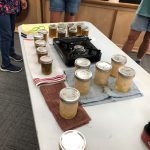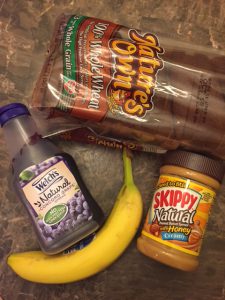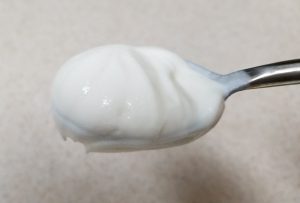
by Claire Davis | Oct 26, 2021

Photo Source: Auburn University IHSA Equestrian Team
Claire Reach is the UF/IFAS 4-H & Family and Consumer Sciences (FCS) Agent in Calhoun County, Florida. For 4-H, she specializes in animal handling, animal safety, and animal sciences. For FCS, she mainly specializes in food safety and healthy living, but has found a new opportunity to work with First Time Homebuyers and the State Housing Initiative Partnership Program (SHIP) in the county.
Claire grew up in Alabama, splitting her time between Birmingham and her family’s farm, L & L Angus Farm, in Auburn. The family farm is Claire’s driving force behind the passion that she has for agriculture, which is a large part of the work she is doing in Extension.

These pictures are of my family on the farm in Auburn, AL. Photo Source: Dave Davis.

Peep some of the cows in the background. Photo Source: Elise Reach.
With a family background in Ag, she decided to study Animal Science-Production Management at Auburn University in Auburn, Alabama. While completing her undergraduate degree, Claire competed for Auburn University’s Intercollegiate Horse Show Association, worked at Auburn University’s College of Veterinary Medicine in a research barn, and continued to work on the family farm. She graduated in May of 2019 with her Bachelor of Science and a minor in Agricultural Business.

Several home cooking/canning classes offered in 2021. Strawberry jam, chicken, pepper jelly, salsa, and mozzarella cheese have been made! Photo Source: Claire Reach UF/IFAS.

The Calhoun County 4-H Horse Club recently started up! (The 2 horses on the right side of the image also belong to me.) Photo Source: Dave Davis.
Shortly after graduation, she moved to Florida to work for Deseret Cattle and Timber as a Heavy Machinery Operator, but soon realized that her passion was Extension. The position in Calhoun County became available and she jumped at the opportunity to apply for it. Having just started in May 2021, Claire has not been with UF/IFAS Extension long, but she cannot wait to see what the future holds for her county. Claire says that she aspires for the Calhoun County FCS Program to be the area’s leading program for adults in practical home practices, whether that be home canning or healthy eating, and healthy living. All the programs that she offers, whether it be 4-H or FCS, follow the same motto: ‘learn by doing’. This drives the experience of each program, allowing participants to fully understand a concept or ask questions when they do not.

These are the “goodest” dogs of all time! Evie (Chocolate Lab), Diesel (Black and White Mutt), and Hank (Bassett Hound-laying down) Peep the chickens, turkeys, cat, and horses in the back ground! Photo Source: Claire Reach UF/IFAS.

This is Chick! For a mare, she’s pretty special. We have a great bond and she trusts me to do just about anything with her (i.e. shoot a gun off of, rope cattle, stand on, lay on, or let little kids ride) Photo Source: Tanner Mayo.
When Claire is not at work, she says there is always more work to be done at home. Living on a functioning livestock operation, she has several animals, including: chickens (about 50 at the moment), 5 guineas, 4 turkeys, 2 cats, 4 dogs, and 3 horses. She hopes to be able to add cattle to the ever-growing “funny farm” soon! It isn’t always about work, though. In her spare time, Claire enjoys spending time with family, riding her horses, long walks with the dogs, dirt road riding, and paddle boarding at the beach!

by Samantha Kennedy | Oct 26, 2021
If baking were a feature film, flour would be the lead actor. While there are a lot of important supporting castmates, flour is the star. It serves as the foundation upon which baking masterpieces are built, providing structure, texture, and mouthfeel (the physical sensations food provides in the mouth) to the final product.
But here is the thing: Not all flours are created equal. There are many types of flour out there, but not all of them will provide the same results. Different types of flour have different levels of protein, gluten, and fiber, and react differently with their companion ingredients. Need all-purpose flour but only have rye flour? Expect a nuttier, grainier outcome – or even possibly a disaster!
Depending on the type of flour used, different quantities of other ingredients may be called for, such as water or oil, salt, butter, sugar, baking soda, or baking powder. Not all flours are easily interchangeable, and some flours can only be partially substituted for others, or the final product may be dramatically different.
For example, want to substitute whole wheat flour for all-purpose flour? Sure, it’s possible, and is much easier to pull off in quick (non-yeast) breads such as muffins, pancakes, and biscuits. However, in yeast breads, switching out 100% of white flour for whole wheat without adjusting other ingredients will inevitably result in a final product that is less airy and more dense (less rise), which may adversely affect the flavor and texture.
What to do? Since whole wheat flour absorbs more liquid than white flour, for every 1 cup of whole wheat flour substituted, increase the liquid by 2 teaspoons, and then let the dough rest for 30 minutes before kneading to allow the liquid to be absorbed. This will result in a softer, more malleable dough that will yield more favorable final results.
There are many more substitution tips out there – more than could possibly be covered in one article. But here are a few common types of flour that may be called for in baking:

All-purpose flour is a common, highly versatile type of flour that can be used successfully in many baking recipes. (Source: Samantha Kennedy)
All-purpose flour: Made from the soft, chewy internal part of the wheat kernel – the endosperm – it is a highly versatile type of flour that can be used in just about any baking recipe. This type of flour generally contains about 10-11% protein.
Self-rising flour: I like to think of this as all-purpose flour with a kick. Why? Because it already contains the salt and baking powder that would otherwise need to be added to all-purpose flour to make the final product rise. While it can be substituted for all-purpose flour, it is important to remember to leave out the additional salt and baking powder called for in the recipe.
Bread flour: This type of flour has a higher protein content than all-purpose flour – about 12% – and produces a dough with more gluten, resulting in a light, airy loaf with good volume. All-purpose flour can be used instead with positive results.
Cake flour: This type of flour contains about 7.5% protein and results in a final product that is crumblier than bread, which is desirable in a cake or cupcake. If using all-purpose flour instead, substitute 1 cup minus 2 tablespoons of all-purpose flour for every 1 cup of cake flour called for in the recipe.
Flour is a vital ingredient in nearly all baked goods. Using too much, too little, or a different kind than called for can result in an unsatisfactory final product. Learning the differences between common types of flour and how they can be interchanged with one another will go a long way towards achieving baking success.
For more information about this or other baking topics, please call Samantha Kennedy at (850) 926-3931.
UF/IFAS is an Equal Opportunity Institution.

by Amy Mullins, PhD, RDN | Sep 24, 2021
September is National Cholesterol Awareness Month. Understanding how to adjust cholesterol and fat in our diet can help to reduce the risks associated with heart disease.
What is Cholesterol? Cholesterol is a waxy type of fat found in all animal cells. This means both the animal-based foods we eat and our own bodies contain cholesterol. Cholesterol is essential for many processes in our bodies, including hormones and vitamin D production. However, we only need a certain amount, and too much can cause problems. Diet and exercise play a key role in keeping our cholesterol levels “in-check.”
Good vs Bad Cholesterol
Cholesterol is often broken down into good and bad cholesterol categories.
- HDL stands for high-density lipoprotein and is considered the good. Higher amounts of HDL can help bring fatty components in your blood back to your liver. The liver helps clear these fatty deposits from your body and can reduce the risk of developing heart disease. You can think of HDL as the helpful cholesterol. HDL can be increased by eating more heart-healthy fats. These are fats low in saturated fat, high in omega-3 and include olive oil, nuts, avocados, and fish.
- LDL stands for low-density lipoprotein and is considered bad. LDL cholesterol does the opposite of HDL. It deposits these fatty deposits to your arteries. You can think of LDL as the lousy cholesterol. LDL can be lowered by reducing the amount of trans fats and saturated fats from the diet. We can also reduce LDL cholesterol by increasing the amount of fiber in our diet.
- According to the CDC, desirable cholesterol values include:
Total cholesterol: less than 200 mg/dL
LDL cholesterol: less than 100 mg/dL
HDL cholesterol: greater than or equal to 60 mg/dL

Choose low-fat or fat-free dairy products for less saturated fat and cholesterol.
Photo credit: USDA SNAP
Cholesterol in Foods
Animal-based foods not only contain cholesterol, but are also high in saturated fat. Our bodies use saturated fats to make cholesterol, which can increase our LDL cholesterol. Limit your intake of these high-saturated fat foods:
- Butter
- High-fat dairy, such as cheese, whole-milk
- Egg yolks
- Fatty cuts of meat, hot dogs, bacon, and high-fat cold cuts
- Animal fat, such as lard, tallow, duck fat
- Fried foods
- Baked goods and snack foods made with lard, butter, palm kernel, coconut oils, or trans-fat
How to Lower Your Cholesterol Intake
- Opt for plant-based fats
- Plant-oils have NO cholesterol!
- They are a great substitution for cholesterol-containing fats such as butter. Not only do they replace cholesterol in your diet but they can also help lessen the absorption of cholesterol from other foods.
- Healthy plant oils include olive, safflower, canola, flaxseed, and sesame oils
- Avocados, walnuts, peanut butter, and other nut-butters are great options!
- Select lean protein foods
- Swap out ground beef for ground turkey or chicken
- Replace grilled steak with grilled chicken or fish
- Remove the extra fat cap on large cuts of meat
- Opt for skinless options of poultry. Skin contains a significant amount of fat.
- Choose low-fat dairy options
- Reach for the low-fat or fat-free options for cheese, yogurt, milk, and cottage cheese.
- This will reduce the amount of cholesterol you eat but still allow you to enjoy these foods.
- Step-up your fiber game!
- Just like plant-based oils, fiber can help reduce the amount of cholesterol you absorb from foods. Fiber creates a gel-like substance in your stomach and can whisk away cholesterol from being taken up into your blood.
- Fiber is in so many delicious foods! High-fiber foods include fruits, vegetables, whole grains, seeds, beans, and nuts.
- To incorporate more fiber into your diet, try:
- Going for a plant-based dinner once a week by including beans, tofu, or lentils instead of meat.
- Making ½ your plate fruits and vegetables at mealtimes.
- Swap refined grains for whole grains, such as brown rice, quinoa, whole-wheat pasta, faro, oatmeal, popcorn.
Replacing foods high in saturated fats with heart-healthy fats can be an effective way to improve your cholesterol levels. This can be as easy as using olive oil in place of butter. Try swapping whole milk in your cereal with 1% or skim milk. Never underestimate how even the smallest changes can make a big difference!
Guest contributor: Stephanie Hill, Master’s student and Dietetic Intern from Florida State University’s Department of Nutrition & Integrative Physiology.
References:
4 ways to eat your way to lower cholesterol. Harvard Health. (2021, February 3). https://www.health.harvard.edu/heart-health/4-ways-to-eat-your-way-to-lower-cholesterol
What is cholesterol? Academy of Nutrition and Dietetics. https://www.eatright.org/health/wellness/heart-and-cardiovascular-health/what-is-cholesterol
Heart Healthy Eating to Help Lower Cholesterol Levels. Cleveland Clinic. https://my.clevelandclinic.org/health/articles/17281-heart-healthy-eating-to-help-lower-cholesterol-levels
Nutrition and Healthy Eating. Mayo Clinic. https://www.mayoclinic.org/healthy-lifestyle/nutrition-and-healthy-eating/in-depth/fat/art-20045550
LDL & HDL: Good & Bad Cholesterol. Centers for Disease Control and Prevention, 31 Jan. 2020, www.cdc.gov/cholesterol/ldl_hdl.htm.

by Amy Mullins, PhD, RDN | Aug 27, 2021

Healthy snacks fuel the athlete! Photo credit: Amy Mullins
When it comes to your kids, you’d do anything to help them succeed… in the classroom, in their relationships, in life. So, why not on the basketball court, soccer field, swimming pool, or whichever sport they’ve fallen in love with? They may have the best equipment, participate in extra training lessons, and put in 110% during every practice and event. But, is this enough? Is there something missing?
It’s no secret that your child is growing. In order to function in their sport, improve performance, and promote recovery, kids need food to help support the increased energy requirements. This ultimately means more planning and more groceries!
Follow these guidelines to fuel your superstar during the week, before the game/event, and after the game/event.
Pre-Game Meal/Snack
Eat a good-sized meal at least three hours before the event. This gives the tummy time to process all the food to prepare it as fuel. Have a light balanced meal with some carbs and fats. These will sustain you throughout your exercise! Carbs and fats are both great fuel sources, and the fats digest slower to help keep you feeling full. Pick foods that digest well to avoid any nausea or upset stomach. Don’t forget to drink some water to start off hydrated!
- Breakfast Ideas: fruit, lightly sautéed potatoes, scrambled eggs, or toast with nut butter or smashed avocado
- Lunch Ideas: turkey or ham sandwich (avoid fatty cheeses and condiments), peanut butter and jelly, fruit, pretzels, or cereal
- Snack 30 minutes before the event: peanut butter crackers, granola bars, fruit snacks, or goldfish crackers
During Practice and Games
For exercise lasting less than an hour, sip on some water to stay hydrated. For exercise lasting longer than an hour, a sports drink like Gatorade or Powerade will help replenish lost carbohydrates and electrolytes. For longer lasting activities or day trips, bring along some easy to eat snacks with lots of carbs, and some fats and proteins. Peanut butter and jelly sandwiches and granola bars are great options!
Post-Game Snack
After exercise, it’s important to recover, refuel, and re-hydrate. Protein will help our muscles recover while carbohydrates will help refuel for the next activity. Drink plenty of fluids to rehydrate! Good choices for quick, easy snacks include chocolate milk, peanut butter crackers, cheese sticks, bananas, apple slices with peanut butter, or smoothies with or without protein.
Dinner Plate After Practice and Games
- Grains/Carbs: Should take up roughly 35% of the plate
- Lean Protein: Should take up roughly 25% of the plate
- Fruits and Veggies: Should take up roughly 40% of the plate
- Hydration: Focus on replenishing lost electrolytes and fluid loss
Components of a well-balanced meal include:
- Meat & poultry – great protein sources for recovery. Pair it with a carb!
- Whole grains, fruit, pasta, rice, potatoes – great carb sources to complement your protein. These will help replace the energy you burned during exercise.
- Water, milk, and fruits will help replenish fluids lost during exercise.
Eating right not only on game day but throughout the week will do wonders for your child’s athletic performance. Not only that, it will set them up to be successful and healthy adults in the future!
Guest contributors: Patrick Burns and E. Jane Watts, Dietetic Interns from Florida State University’s Department of Food, Nutrition, and Exercise Sciences
The use of trade names in this post is solely for the purpose of providing specific information. It is not a guarantee, warranty, or endorsement of the product.
References:
Academy of Nutrition & Dietetics. Ellis, E. (2020). Hydrate Right. https://www.eatright.org/fitness/sports-and-performance/hydrate-right/hydrate-right
American Dietetic Association, Dietitians of Canada, American College of Sports Medicine,
Rodriguez, N. R., Di Marco, N. M., & Langley, S. (2009). American College of Sports Medicine position stand. Nutrition and athletic performance. Medicine and science in sports and exercise, 41(3), 709–731.
https://performancepartner.gatorade.com
https://www.eatright.org/fitness/sports-and-performance/tips-for-athletes/gameday-nutrition-tips-for-young-athletes

by Samantha Kennedy | Aug 24, 2021
What do you think of when you hear the word bacteria? If you are like most people, you probably think of those teeny, tiny germs that are invisible to the naked eye, but have the potential to cause serious illness. And while you would not be wrong to think that way, you would be leaving out a huge percentage of bacteria that are considered “good” bacteria.
The common name for “good” bacteria is probiotics (from the roots pro and biota, meaning “for life”). They are a group of beneficial microorganisms that have been shown to improve a variety of digestive and other conditions, such as irritable bowel syndrome and urinary tract infections.

Foods like Greek yogurt are a good source of probiotics, which have been shown to have a positive effect on digestive health. (Photo source: Samantha Kennedy)
Probiotics are found in a variety of foods, primarily fermented foods such as Greek yogurt and cottage cheese, fermented drinks such as buttermilk and kombucha, and pickled vegetables such as pickles and sauerkraut. The bacteria required for the fermentation process – the process that gives these foods their tangy flavor – have been shown to provide natural health benefits.
The primary benefit of probiotics is their positive effect on a variety of gastrointestinal ailments such as diarrhea, ulcerative colitis, Crohn’s disease, and stomach ulcers. According to Harvard Medical School, probiotics can also help reduce the presence of harmful bacteria, such as H. pylori and C. difficile, both of which can cause digestive problems.
In Northern Europe and many Asian countries, people get probiotics mainly from food sources, where fermented foods are consumed more regularly. Here in the United States, many people get probiotics from over-the-counter (OTC) supplements. These products are not regulated by the Food and Drug Administration, however, so when choosing OTC supplements, be wary of the claims they make.
The information about probiotics is not all positive, however. Some people report an increase in diarrhea after taking probiotics for the first time, which usually goes away with time. Also, people with a compromised immune system may experience illness caused by probiotics if too many are taken.
That being said, OTC probiotics have also been shown to have positive effects on health, when taken as directed. However, they are not a cure-all, and more research needs to be done to learn more about their complete effects on gastrointestinal health and immune support. Just like with other supplements, it is important to consult with a physician or pharmacist before beginning a probiotic regimen.
So, what is the final word on probiotics? Well, it depends. While they are not a magic bullet that can cure everything that ails you, they can be a positive addition to a healthy diet. Many foods that contain probiotics also contain other important nutrients such as protein, vitamins, and minerals, which are an important part of a nutritious diet.
One more thing: do not confuse prebiotics with probiotics. Prebiotics are non-digestible, short-chain carbohydrates that serve as fuel for probiotics. On their own, they do not offer any health benefits, but they can serve to promote the growth of probiotic species. Foods with high amounts of prebiotics include fruits and vegetables and whole grains, so a diet rich in these foods can help promote the growth of beneficial bacteria.
To learn more about probiotics, please contact your local Extension agent.
UF/IFAS is an Equal Opportunity Institution.

by Ginny Hinton | Aug 8, 2021
If you’ve tried to find nutrition information in the midst of the Covid-19 pandemic, you probably got more than you bargained for. Recently, I searched “nutrition and COVID-19” and in less than one second, I got 590,000,000 hits. That’s a lot of information! With so much health and nutrition information available, especially connected with the ongoing pandemic, it can be TOUGH to separate fact from fiction. What makes it even tougher is that everyone seems to be passionately and totally convinced that their information is the right answer. How do you tell the hype from the truth?

Confusing Nutrition Choices
Photo Source: Ginny Hinton
The best way to protect yourself against questionable information and products is to become an informed consumer. That can be challenging as so many of us are becoming more used to getting our information from social media, websites, advertisements, friends and family. While information from those sources can be accurate, very often it is misleading. Use the following tips to evaluate nutrition information:
Know Your Experts:
Have you ever seen nutrition advice from a “nutritionist” or “diet counselor”? Beware, because those terms aren’t regulated, and almost anyone can use them to look like an expert. Registered dietitians (RD) or licensed dietitians (LD) hold specialized degrees and are good sources of solid nutritional information.
Media Sources:
The internet, books, newspapers, and magazines can be good sources of information, if you know where to look. If you’re surfing the net, select websites from credible web addresses like ones ending in .edu (universities or medical schools), .gov (government agencies), or sometimes .org (not-for-profit research and education). If you’re reading an article, always look for the author’s qualifications and membership in a professional nutrition organization. With all media, check the sources they used (If they don’t cite credible sources you can check, that’s a big red flag) and scan to the bottom to make sure they’re not trying to sell a product. If you can buy a “miracle” product, a solution, or a quick fix from them, watch out! Their information may be convincing, but it is likely biased or incomplete. At best, it calls for caution and some deeper research.
The flood of health and nutrition misinformation isn’t going away, but learning to be an informed consumer is a powerful step in learning to protect yourself from being duped.


















